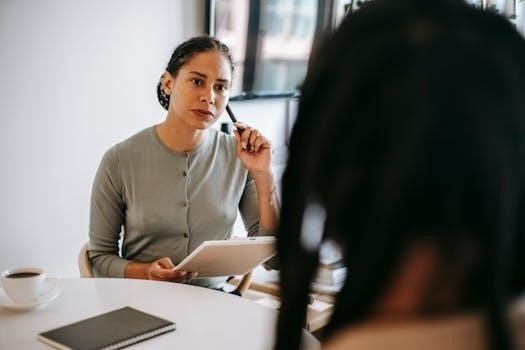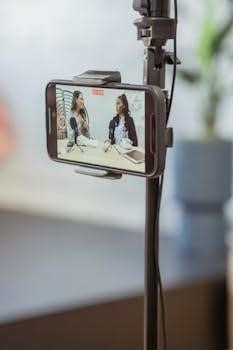how to talk anyone pdf

Effective communication is a vital skill for building relationships and achieving success․ It involves both verbal and nonverbal cues․ Mastering these techniques can greatly improve social interactions and rapport․

Overview of “How to Talk to Anyone”
Leil Lowndes’s “How to Talk to Anyone” is a comprehensive guide, offering 92 practical techniques to enhance social skills and conversations․ It aims to equip individuals with the tools to navigate various social situations with confidence and grace․ The book delves into both verbal and nonverbal communication strategies․ It presents a structured approach to building rapport and making positive connections․ The techniques range from simple conversational starters to more advanced strategies for creating lasting impressions․ It emphasizes the importance of adapting one’s communication style to different people and contexts․ This book is designed to be accessible to individuals at all levels of social skill, providing valuable insights for both beginners and those seeking to refine their approach․
Key Communication Techniques
Key communication techniques involve mirroring, matching, and active listening․ These methods build rapport and encourage open dialogue, fostering deeper connections and understanding between individuals․
Mirroring and Matching
Mirroring involves subtly imitating another person’s facial expressions and body language․ This technique creates a feeling of comfort and rapport, making the other person feel more at ease․ It’s a non-verbal way of saying, “I understand you․” Matching, on the other hand, focuses on aligning your pace and tone with the other person’s communication style․ This includes matching their speaking speed, volume, and even their choice of words․ When you mirror and match effectively, you establish a subconscious connection that can make your interactions smoother and more productive․ Remember to do it subtly and genuinely to avoid appearing insincere․
The Power of Listening
Listening is a crucial aspect of effective communication, often undervalued․ It involves more than just hearing words; it requires active engagement and focus on the speaker․ Being a good listener means paying attention to both verbal and nonverbal cues, demonstrating genuine interest․ It’s about understanding the speaker’s perspective, not just waiting for your turn to talk․ Empathetic reflection, repeating what the speaker said in your own words, shows you’re truly engaged․ Listening attentively not only makes the other person feel valued but also allows you to gather valuable information, fostering deeper connections and better understanding in any conversation․
Nonverbal Communication Skills
Nonverbal cues, such as eye contact and body language, significantly impact communication․ Awareness and control of these signals enhance understanding and create stronger connections․
Eye Contact Techniques
Effective eye contact is crucial for building trust and rapport․ The “Sticky Eyes” technique suggests maintaining eye contact even after the other person has finished speaking, creating a sense of engagement․ Avoid immediate smiling; instead, pause briefly and then make eye contact․ The “Epoxy Eyes” technique involves focusing on your conversation partner, even when others are talking, signaling that you are fully present and attentive․ Proper eye contact conveys confidence and interest, while avoiding prolonged staring․ These techniques will help you come off as engaged and make them feel heard․ Employing these subtle but powerful cues can significantly enhance your communication skills․
Body Language Awareness
Understanding body language is essential for effective communication․ Pay attention to your posture; make sure you are stretched into the perfect position, as this exudes confidence and engagement․ Be mindful of your facial expressions and try to mirror the other person’s cues subtly․ Avoid closed-off postures and instead maintain an open stance․ Use gestures that complement your words rather than distracting from them․ Notice the nonverbal signals of your conversational partner to gauge their interest and engagement․ Be aware of the space you occupy․ All these nonverbal aspects contribute to the overall message you are conveying, and it is important to be mindful of these subtle cues․
Conversation Strategies
Engaging conversations involve asking thoughtful questions and sharing personal information appropriately․ It is important to actively listen and adapt the topic as needed to keep the interaction flowing smoothly․
Asking Effective Questions
Asking effective questions is crucial for stimulating meaningful conversations and showing genuine interest in others; Instead of generic inquiries, opt for questions that encourage deeper thought and sharing․ Open-ended questions like “What are you passionate about?” or “What did you enjoy most about your day?” can lead to richer, more engaging discussions․ Avoid questions that elicit simple yes or no responses․ Genuine curiosity will make the other person feel valued and heard․ Remember to listen actively to their answers, and build upon their responses with follow-up questions․ This approach will not only keep the conversation flowing but will also create a more personal connection․ Asking good questions is a powerful tool for fostering rapport and understanding․
Sharing Personal Information
Sharing personal information is a key element in building trust and deepening connections with others, but it should be approached with discernment․ It’s essential to strike a balance between being open and not oversharing․ Begin by offering small, relevant details about yourself, such as your hobbies, interests, or experiences, and gauge the other person’s comfort level․ Avoid divulging too much too soon, particularly on sensitive topics․ Sharing should be reciprocal, creating a comfortable and natural flow of information․ Pay attention to the other person’s responses, and adapt your level of sharing accordingly․ Sharing personal information can foster a sense of vulnerability and authenticity, which can significantly enhance the quality of your conversations and relationships․ It’s about building a connection, not just broadcasting your life story․

Building Rapport and Connections
Building rapport involves creating a sense of understanding and connection with others․ Using compliments effectively and fostering a comfortable atmosphere are key techniques to achieve this․

Using Compliments Effectively
Offering genuine and specific compliments is a powerful way to build rapport․ Instead of generic praise, focus on noticing and acknowledging particular qualities or actions that you admire in others․ This shows that you are attentive and sincere․ Authentic compliments make people feel valued and appreciated․ Avoid insincere or over-the-top praise․ When delivered correctly, specific compliments can create positive emotions and strengthen connections․ They are an excellent tool for making others feel good, which is crucial in building rapport and creating a comfortable atmosphere․ It’s important to ensure the compliment is appropriate for the context and relationship, focusing on genuine admiration․

Creating a Comfortable Atmosphere
Establishing a comfortable atmosphere is essential for open and engaging conversations․ This involves making others feel relaxed and at ease․ One key element is to be a good listener, genuinely interested in what the other person has to say․ Using mirroring techniques, such as matching pace and tone, can also foster a sense of connection․ It’s important to avoid creating an environment of judgment or pressure․ Instead, focus on creating a space where people feel safe to share their thoughts and feelings․ A relaxed and supportive setting enhances communication and builds stronger connections․ This also involves being mindful of body language and non-verbal cues to ensure that you’re sending signals of openness and acceptance․